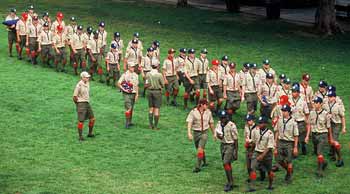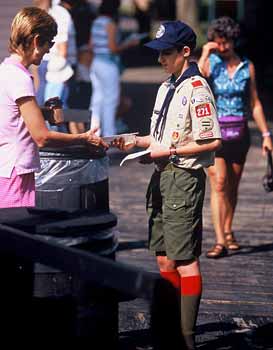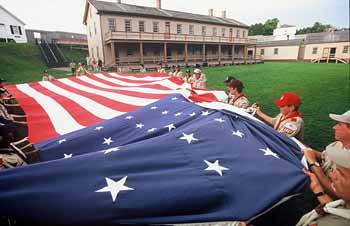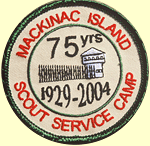A 75-Year Tradition of Summer Service
By Suzanne Wilson
Photographs By Craig Van Der Lende
Scout troops celebrate more than seven decades of duty as special service units at Michigan's historical Fort Mackinac.
- Some Highlights in the 75-Year History of the Scout Service Camp
- One Week on Mackinac Island
- Fort Mackinac: From Frontier Fort to Prison To Historic Landmark
On a Saturday afternoon, Boy Scouts and leaders from six troops in the Detroit Area Council walked off a ferry and onto Mackinac Island, located in Lake Huron between Michigan's Lower and Upper Peninsulas.
 Service camp Scouts retire following the evening flag lowering ceremonies. |
As they approached Main Street, they heard the clip-clop of horses' hooves and the whir of bicycle wheels. Motor vehicles are not allowed, and visitors are reminded of the Victorian era, when fine hotels and summer homes were built on the island.
Beyond that era, Mackinac's earlier history encompasses Native American tribes, French fur traders, Jesuit missionaries, the British military, and our country's path to independence.
The 53 Scouts walked up to Fort Mackinac, on a bluff above the bay. From July 31 to Aug. 7, 2004, they would be part of the 75-year tradition known as the Mackinac Island Scout Service Camp, a program dating back to 1929.
Although the Scouts came from six troops, for the week they would be considered as members of the week's official host unit, Troop 194, chartered to St. Gregory the Great Catholic Church of Detroit (see sidebar).
In performing this annual service to their state and to Mackinac Island State Park, the Scouts would raise and lower 27 flags each day at the fort, at the state governor's summer residence, and in the town. And they would also welcome tourists at the fort and historic buildings.
But today was for exploring the fort, watching a film about island history, and, in the evening, participating in the 75th anniversary celebration of the Scout service camp (see sidebar).
In the evening, alumni from service camps dating back seven and a half decades gathered at the fort's parade ground. Troop 194 opened the celebration by raising the huge garrison flag, the 38-star American flag of the 1880's.
Phil Porter, director of Mackinac State Historic Parks, described the service camp tradition as a "win-win" effort.
"It's a win for Scouts who have an unforgettable, enjoyable experience at Mackinac," he said, "and a win for the Mackinac Island State Park, which receives 30,000 volunteer hours each year from these dedicated Scouts."
State Senator Jason Allen, an Eagle Scout and executive board member of the Scenic Trails Council, Traverse City, Mich., spoke of the value that Scouting experiences have had in his career and encouraged Scouts of Troop 194 "to keep on the Scouting path."
 Tour guide Colin Bonathan greets visitors and hands out information pamphlets. |
State Representative John Stewart, an Eagle Scout and service camp alumnus, recalled the summer he met then-Governor George Romney at the Scout barracks. "The governor came down for ice cream and played softball with us," he remembered.
Stewart presented parks director Phil Porter with a wood carving of the Eagle Scout badge, to be placed in the barracks.
"Soldiers," members of the fort's interpretive staff, fired rifles, a round in honor of each Scout troop represented at the event. The ceremony ended, and the mammoth U.S. flag was lowered. At 20 by 36 feet, the banner required 30 Scouts to fold it.
In a theater inside the fort's commissary, alumni and families watched a video collage of photos from past camp seasons.
Many in the audience recognized Marshall Van Riper, 90, when he was a teenager wearing jodhpur-style pants that were once part of the Scout uniform. "I haven't changed a bit, have I?" he asked with a smile.
Alumni stayed to reminisce. Two veterans of the 1954 service camp, Mort Mattson and Norm Lyon, noted that after their service period ended, they made a plaque bearing the words of a Scout grace that still hangs in the barracks dining hall.
"It was the last thing I did as a Scout," recalled Mattson.
A week at service camp
"We are the Boy Scouts...the flag-raisin' Boy Scouts. Sound off!"
Each morning, the sounds of their voices and marching feet let people know the Scouts were on their way to raise the flags of the nations that have figured in island history.
"The troop is a vital part of the life of the island for a week," said Henry Vassel, camp director for this troop.
Most Scouts served as guides, three patrols working three-hour shifts at posts where they greeted tourists and answered questions.
Colin Bonathan, 13, said "Good morning" to visitors who climbed the long ramp to the fort's south sally port. He handed out pamphlets identifying fort buildings and listing events of the day, which included concerts of military music, court martial re-enactments, and cannon firings, all conducted by members of the park's interpretive staff in uniforms of the 1880's.
"Is a real cannonball going to come out?" a little girl asked Scout Charlie Bounty, 13, who was stationed at the upper gun platform.
"No," Charlie reassured her with a wink, before politely moving people back from the ropes surrounding the cannon.
The gun crew pointed out its "target"—a buoy floating in the bay. The cannon boomed, and smoke billowed from the barrel, followed by the sound of a clank!—obviously coming from nearby.
"We got it!" yelled a soldier, as the crowd laughed.
In the town below the fort, John Palgut, 15, co-patrol leader, greeted visitors at the McGulpin House, built about 1780. With him was Craig Lytle, 18, assistant director of the staff who supervised the Scout guides.
"We make sure they're smiling and having a good time at their posts, give them water and bathroom breaks," he said.
In previous years, both Scouts served as guides at the governor's summer residence on the island and met Michigan Governor Jennifer M. Granholm.
 The celebration of the Scout Service Camp's 75th anniversary officially ended with the lowering of the garrison's 20-by-36-foot flag, which required 30 Scouts to fold it. |
"When we first came here, I didn't realize the Boy Scouts were so much a part of the island summer," John said.
"There's a lot of history on the island," Craig noted, "and the Scouts get to be at the center of it all."
Besides guides and guide staff, Scouts participated as service staff—cleaning the barracks each morning and helping with cleanup after meals.
And everyone was ready to respond to the park staff's special requests for help—tasks like painting park benches, maintaining trails, or running errands.
However, there was also time for trips downtown to buy some of the island's famous fudge and to ride bicycles.
One evening, patrols and staffs competed in "Discover Mackinac." They solved riddles revealing historic and natural locations on the island, and then raced to be the first to reach each site. Jon Cook, 16, called it "cross-country with clues."
Many happy returns
The park staff grades each service camp troop after its week on duty and then decides whether to recommend if it should return the following year.
Troop 194 gets high grades and returns regularly, each time with about two-thirds of its Scouts as veterans of previous summers and one-third being first timers. Soon after arriving, old hands and newcomers are marching together and teaming up to perform their flag-raising duties.
"They have to learn to work together and get to know each other quickly," said Brad Simmons, camp program director. "It always comes together rather magically, and the boys really look good."
Because the Scouts in a service troop can come from several different home troops, new and lasting friendships are a major reward of the week on the island.
Trace Dominguez and Andrew Smith, former service campers and now college students, worked in 2004 as soldiers on the fort's interpretive staff.
"Mackinac really gets in your blood," Dominguez said. "The island is one of my favorite spots."
Most of the 10 adult troop leaders once served here as Scouts, too. In fact, except for his years in military service, Henry Vassel has attended the camp since 1942, first as a Scout with Troop 194 and then as a leader.
Throughout the year, he works on planning with Simmons and Tom Brand, a longtime Troop 194 leader and Scout service camp veteran who now assists in annual preparations. In the spring, 20 leaders and Scouts from this particular group go to the island to ready the barracks for summer.
Dan West, service staff director, says, "It's really cool to be able to contribute to something as an adult that meant so much to you as a kid. I want to be part of the next generation to help keep it going."
Contributing editor Suzanne Wilson lives in Joplin, Mo.
Some Highlights in the 75-Year History of the Scout Service CampDuring the 75th anniversary of the Scout Service Camp on Mackinac Island, former crew members reminisced about the past, possibly recalling some of these historical moments:
1934—In the only year Scouts from other states were invited, 40 Eagles from 15 states attended. The Scout barracks was built north of the fort. 1939—The camp was opened to individual Boy Scout troops from Michigan, with the rank of Eagle no longer required. 1940's—A different troop arrived to serve each week of the summer. 1950's—Scouts were posted at stations to greet tourists rather than conduct tours. Additional flags and posts at historic town buildings required more Scouts. 1960's—Scouts from several troops joined together for a week of camp, supplying more Scouts for the program and extending the honor to more troops. 1974—Girl Scout troops began service that continues to the present. 1975—President Gerald R. Ford's helicopter landed in front of the Scout barracks, and the president walked over to shake hands with all the Scouts. The 2004 camp ran for 14 weeks, with a minimum of 50 Scouts needed to perform the required duties during each session. Boy Scout troops staffed the camp for eight weeks, with seven different Michigan councils coordinating the selection of participating troops. Camp duties during the other six weekly sessions were handled by Girl Scout units. —S.W. |
Fort Mackinac: From Frontier Fort to Prison To Historic LandmarkAt historic Fort Mackinac, it's always the 1880's. Most of the restored buildings were constructed then, and the interpretive staff portrays military life of that time. The Scouts' knowledge of island history goes back much further. They know American Indians named the island Michilimackinac, Land of the Great Turtle, because of its shape, like a turtle's back. French fur traders and Jesuit missionaries arrived in the 1670's. In 1780, during the American Revolution, the British built Fort Mackinac on a bluff overlooking the bay. When the Peace Treaty of 1783 established a Great Lakes border between British Canada and the United States, the island belonged to the U.S. side—although the British didn't leave the fort until 1796. Sixteen years later, in the War of 1812, the British invaded the island, and the outnumbered Americans surrendered. The fort remained in British hands until after the war, when it was returned to the Americans. During the Civil War, the fort was used by the Union as a prison for Southern sympathizers. Following the war, the island became a popular summer vacation destination. By 1895, soldiers were gone from the fort, and it was part of Michigan's first state park. Mackinac Island is now a National Historic Landmark. —S.W. |
One Week on Mackinac IslandThe Scouts participating in the Mackinac Island Scout Service Camp during the week of July 31 to Aug. 7, 2004, represented six troops from the Detroit Area Council. Troop 194, Detroit, chartered to St. Gregory the Great Catholic Church, has served at the camp since 1941 and was designated the host troop. Other units represented included Troop 1029, Birmingham, Our Lady Queen of Martyrs Catholic Church; Troop 1037, Bloomfield Hills, St. Hugo of the Hills Catholic Church; Troop 1539, Plymouth, Fiegel Elementary School PTO; Troop 271, Livonia, St. Michael's Catholic Parish; and Troop 1036, Bloomfield, Kirk in the Hills Presbyterian Church. —S.W. |
May - June 2005 Table of Contents
Copyright © 2005 by the Boy Scouts of America. All rights thereunder reserved; anything appearing in Scouting magazine or on its Web site may not be reprinted either wholly or in part without written permission. Because of freedom given authors, opinions may not reflect official concurrence.
 1929—Roger M. Andrews, vice chairman of the Mackinac Island State Park Commission, invited eight Michigan Eagle Scouts to serve as "honor guardsmen" to Michigan's governor at Fort Mackinac for the month of August. They raised and lowered flags, fired the sunset gun, and conducted tours for tourists. One of these Scouts was young Gerald R. Ford, later 38th president of the United States.
1929—Roger M. Andrews, vice chairman of the Mackinac Island State Park Commission, invited eight Michigan Eagle Scouts to serve as "honor guardsmen" to Michigan's governor at Fort Mackinac for the month of August. They raised and lowered flags, fired the sunset gun, and conducted tours for tourists. One of these Scouts was young Gerald R. Ford, later 38th president of the United States.